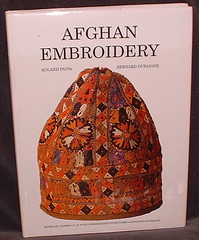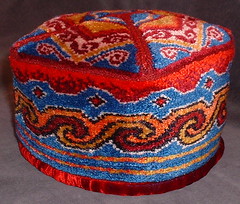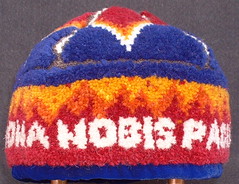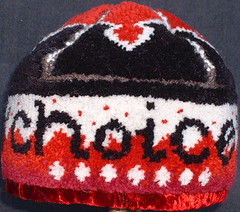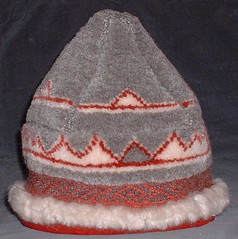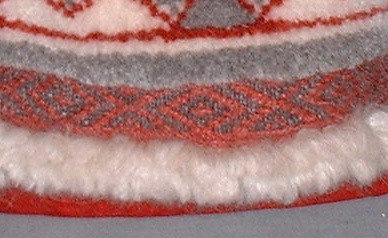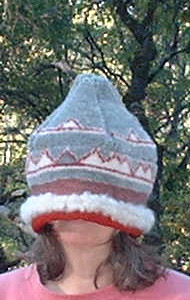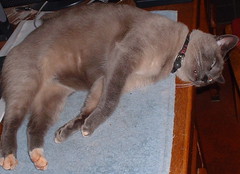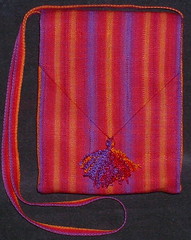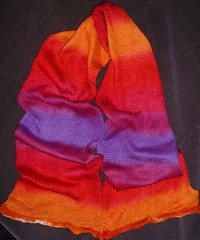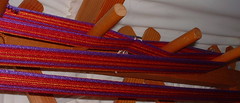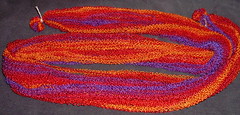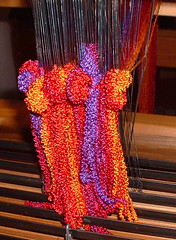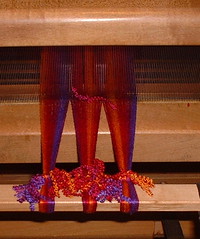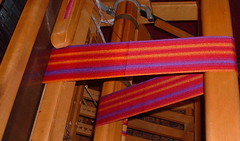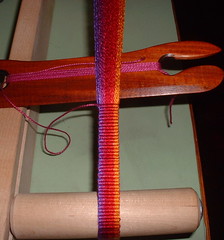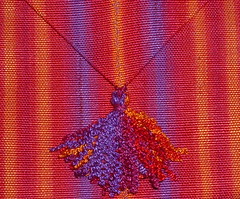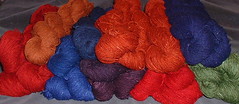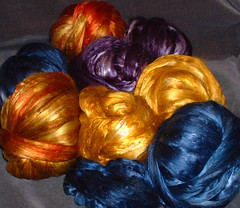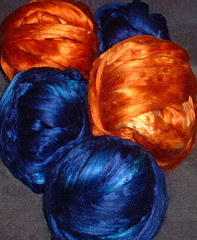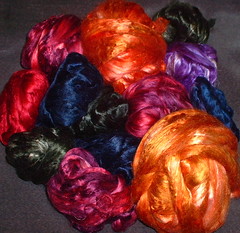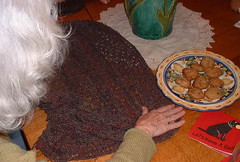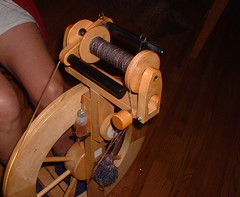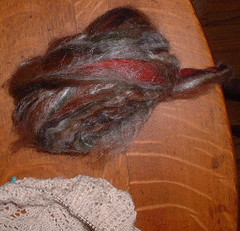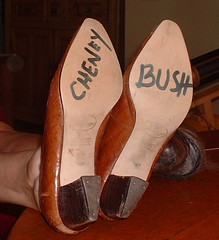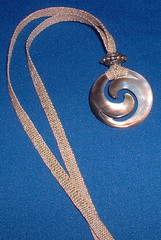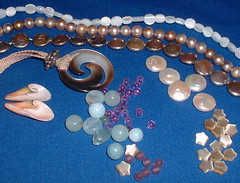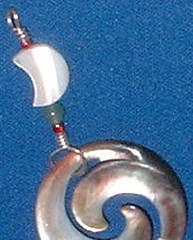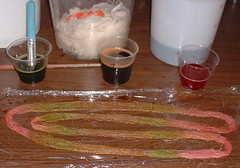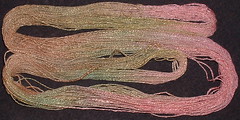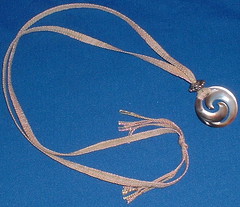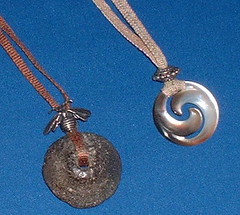First of all, thanks for all of your comments on my last post on weaving a simple silk band. Sometimes a project just seems
right, things fall into place, and all works well together. I can never predict which project this will be. I like to say 1 out of every 10 projects is a success, but that's a guess. I just know that not everything works out to my satisfaction, and yet I still work at it.
But why? Why do we persist? What brought me to weaving, as opposed to say, pottery (which I so admire, and always wanted to do). There must be some inherent satisfaction in just the doing, for some of us, for those of us who do things. It's not always the product, because heaven knows we could buy it for cheaper at [
insert the name of your local discount store here].
I came to weaving at about the same time as raising a family. Weaving was something to occupy my mind while caring for small children. As anyone who has raised children knows, there is very little *adult* in the caretaking, cleaning and cleaning again that goes along with childcare. Weaving can be demanding, thoughtful, entertaining and fun to think about, while scrubbing mud out of small shoes, or sweeping sand off the floor (again), or standing in line at the grocery store, closely examining the fabric of the jacket on the person ahead in line, while seeming to be nonchalant.
Weaving is everywhere. It wraps around us everyday, mostly unsung and un-noticed. I have made an effort to share my joy and pleasure in weaving, and am delighted to find new reasons to cajole potential
victims new weavers into trying a few things. Jane Patrick's new book
Time to Weave illustrates well that weaving is anywhere and everywhere, accessible and fun.
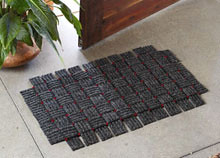
I've had a chance this week to interview Jane, as part of the
Interweave Press blog
tour announcing her new book:
1.Your new book Time to Weave is beautiful and contemporary, the projects
are timeless. The book could be classified as Weaving, or Contemporary
Craft, or even under Home Decoration. Who is your target market?This is a good question. I think what I had in mind and Interweave had in
mind was a book for people who like to make things with their hands to try
weaving on a simple scale. By presenting attractive, simple-to-make projects
my hope was to inspire readers to want to learn more. However, I think the
book has a broader market because of the response I've seen. Even weavers
with very sophisticated equipment are getting excited about making projects
from the book. I've also heard from teachers who are finding good ideas in
Time to Weave to use in their classrooms.

2. There is braiding, plaiting, weaving and twining, such a wide variety of
textile techniques used in the projects: did you plan ahead of time which
techniques you wanted to present?No. The techniques really came as I developed ideas for projects. I wanted
to make, for example, a choker and found that an 8-strand braid produced the
look I had in my mind.
3. Did the materials, or the finished idea come first? How did you choose
the projects?Generally, all the projects started from a concept. I knew, for example,
that I wanted to make a window hanging. I had set equipment parameters, such
as only using frame looms. So, the first thing I tried was working on a
large frame but I found it too cumbersome and I didn't like the look I was
getting. Also, I decided if it was too hard for me, I couldn't expect my
reader to be successful either. Then came a period of just sitting with the
idea and finally I came up with cutting plastic sheeting used for windows
and weaving with ribbon. It gave me the result I wanted and happened to not
require a loom.
4. Some of the materials are very non-textile oriented: I imagine you
wandering the aisles of the local home store, wondering how you can use
*this* or *this*. You stretch the definition of yarn, and textile in the
projects. Was this a fun diversion from your usual textile projects, or do
you usually think *textiles* in all things?Like most people who get involved in textiles, I see the world in textures
and lines and shapes that I can't help but translate into textiles.
Everything seems to be a potential textile or an idea for a textile. I had a
lot of fun at the hardware store. Working on this book, really truly, was a
blast.
5. The tools you use range far a field from traditional textile tools, mat
knives, glue sticks, pliers, hammer and drill (!). Many of the tools and
materials cross over from other crafts: quilting, sewing, even gardening,
integrating weaving ideas into other crafts. Weaving is integrated into
everything we do, but often goes unnoticed. Was it part of your intent to
make the idea of weaving just part of everyday life?Sara, weaving as part of everyday life would be my dream come true! But
seriously, I did want to make weaving "just another craft", like scrap
booking or knitting. I don't know that I was always intentional about the
tools I chose but I did think that the reader of my book would be familiar
with the tools I was using as well as a variety of craft techniques.
Perhaps, secretly, I hoped this would also lend a familiarity to the process
of weaving.
6. The book seems to progress in an organic way to the textile orientation
of weaving: the projects start with non-textile materials and gradually move
into more yarn, fiber and fabric, culminating with woven pile (be still my
heart). Is this a sneaky way to bring new people around to the
accessibility of weaving? If so, congratulations, I think the book will work
well as a subversive guide for people formerly intimidated by the thought of
Weaving, and introduce it as merely weaving, part of the world around us.
Thanks!What you say is true, but I didn't feel sneaky about it. (But maybe what you
say is true, and frankly, if it is, I'm all for it.) Honestly, though, it
was important to me that a few projects be what I consider "real weaving".
That is, a loom that is warped with yarn and a weft of yarn crossing it. I
wanted to introduce some weaving techniques such as the pile in the Pillow
Patch, but I didn't want to be too teach-y (which is my tendency). I just
tried to expose people to weaving and hope that they'll say, "Wow, I really
love doing this. I want to WEAVE."
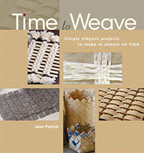
Perhaps this last question illustrates my propensity for underhandedness, for slipping weaving into every conversation, for trying to hoodwink the few people who are still unaware of weaving as a craft. This new book will be another tool in a bag of tricks, useful in presenting weaving as an everyday event, and
tricking teaching new people to weave.
Jane is the former editor of
Handwoven Magazine, to which I have subscribed since the very first issue. When it arrived in those early days, I would save the magazine until evening, when the boys were in bed, and I could devour every word. Thank you Jane, for a fine new book, and thank you Interweave, for all of your fine work over the years: without you, I would not be who I am today.
